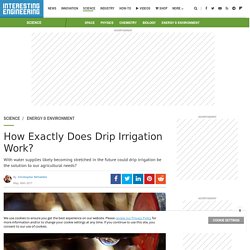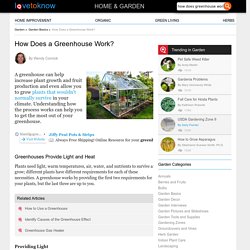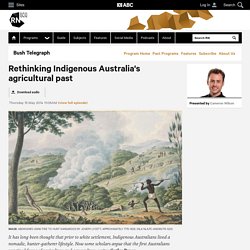

Irrigation Made Easy - Fact Sheets - Gardening Australia - GARDENING AUSTRALIA. SERIES 24 Episode 22.

Watering Systems & Garden Irrigation Advice. How Irrigation Works. Starting an herb garden in a box on your windowsill or spending a Sunday afternoon planting flowers seems quite different from managing two hundred acres of watermelons, but in fact the underlying principle is the same.

How Exactly Does Drip Irrigation Work? Over recent years, there have been considerable technological advancements in irrigation.

One of the more effective of which is drip irrigation. Irrigation technologies, put simply, provide water to plants, and methods for doing so can vary widely. Techniques for irrigation can range from surface irrigation techniques, either through channels or completely flooding the field, to the more precise and controlled method of drip irrigation. Other examples include overhead irrigation which, consequently, creates a lot of runoff. How Does a Greenhouse Work? A Simple Explanation... Heating a Greenhouse. Greenhouses create a sheltered environment for plants by using solar radiation to trap heat.

This system of heating and circulating air helps to create an artificial environment in a greenhouse that can sustain plants when the outdoor temperature is too cool or variable. Heat enters the greenhouse through its covering of glass or plastic and starts to warm the objects, soil and plants inside. The warmed air near the soil begins to rise and is immediately replaced with cooler surrounding air that starts to heat up.
This cycle raises the temperature inside the greenhouse more rapidly than the air outside, creating a sheltered, warmer microclimate. How Does a Greenhouse Work? A greenhouse can help increase plant growth and fruit production and even allow you to grow plants that wouldn't normally survive in your climate.

Understanding how the process works can help you to get the most out of your greenhouse. Greenhouses Provide Light and Heat Plants need light, warm temperatures, air, water, and nutrients to survive and grow; different plants have different requirements for each of these necessities. A greenhouse works by providing the first two requirements for your plants, but the last three are up to you. Providing Light Greenhouses are made mostly of translucent materials, usually in the form of either glass or clear plastic. Providing Heat. How To Build A Greenhouse - Gabriel Ash - Gardeners Corner. If having a greenhouse is your dream but you are on a tight budget, buying a high-quality kit and building it yourself could be the solution.

Not only will you save on installation costs but also on all the associated expenses, such as preparing the ground and laying foundations. Once you have completed the groundwork, you can order your greenhouse and start building. Get the site right Not only will you need to ensure that your site and foundations are totally level but also you will need to pay careful attention to where you site your greenhouse. A south or south-east facing site is best, as the solar gain from putting your greenhouse in the ideal site can save money on heating costs. Greenhouse Facts for Kids. Useful websites and resources – Agriculture and Food Week. Robotic Agriculture. Research and Innovation. Australia’s primary industries have a strong tradition of being innovative and adaptive to new challenges.

They have proven to be highly efficient and competitive in international markets. The outlook for the Australian primary industries sector is strong, with the world’s demand for food rising, driven by population growth and calls for higher quality and greater variety of food. Rethinking Indigenous Australia's agricultural past - Bush Telegraph - ABC Radio National (Australian Broadcasting Corporation) It has long been thought that prior to white settlement, Indigenous Australians lived a nomadic, hunter-gatherer lifestyle.

Now some scholars argue that the first Australians practised forms of agriculture and aquaculture, writes Cathy Pryor. When explorer and surveyor Major Thomas Mitchell ventured into Australia’s inland in the early 1800s, he recorded in his journals his impressions of the landscape. Around him he noted expanses of bright yellow herbs, nine miles of grain-like grass, cut and stooped, and earthen clods that had been turned up, resembling ‘ground broken by the hoe’. Mitchell, like other early explorers, noted what many white Australians would later overlook: there was evidence everywhere on this vast continent that Aboriginal Australians managed the land. Historians, writers and academics are now rethinking Australia's perception of Indigenous land management.
Farming and food production. Farming and food production Our diverse food and farming research ranges from studying the make-up of our crops and animals to the methods and food processing technologies we develop to produce healthier, safer and more sustainable food. Our research Breeding better animals From developing premium feeds right through to gene technologies, we're helping Australian farmers breed outstanding produce. Growing robust crops When we understand the risks to a crop, we can modify the species to protect them from specific threats.
Improving farming techniques From responsive modelling to intuitive digital technologies, we're developing practical solutions for the agricultural community and industry. Innovation and technology for the future We've developed a range of tools and techniques to answer today's challenges and plan for the future, including gene technology, digital modelling and region-specific strategies.
10 Things You Can Do to Help Save the Earth. Going green is easier than you think. There are little things you can do every day to help reduce greenhouse gases and make a less harmful impact on the environment. Taking care of the Earth is not just a responsibility -- it's a privilege. In that spirit, HowStuffWorks came up with 10 things you can do to help save the Earth. 1. Pay attention to how you use water.
Global Warming Facts. Have you heard about Global Warming?

Well our planet is changing as a result of it, and we’re going to give you all the facts as to why! Everybody is seeing changes all over the world, from glaciers that are melting, temperatures that are rising, storms and floods are more viscous and extreme, causing loads of damage. It’s even affecting our wildlife as insects are coming out earlier, and flowers are blooming earlier too. In some places bears have even stopped hibernating and birds are laying eggs way before they’re meant to.
Those are some serious changes that we’re seeing. The Earth – A Natural Greenhouse. Global warming for kids: A simple explanation of climate change. Advertisement by Chris Woodford.

Last updated: October 20, 2018. It's hard to think of many things powerful enough to disrupt life across our entire planet. Huge natural disasters—like earthquakes, erupting volcanoes, or tsunamis (freak tidal waves)—can affect many thousands of people, but their impacts are usually confined to just one region of the world. Terrorist attacks cause worldwide panic and horror, but their effects are usually quite localized. Global warming, which is a gradual rising of Earth's temperature, is different from all these, representing a scale of threat greater than anything humans have faced in recent history. Photo: Is global warming too hot an issue for politicians to handle? What is "global climate change"? The Short Answer: Climate change describes a change in the average conditions — such as temperature and rainfall — in a region over a long period of time.
NASA scientists have observed Earth’s surface is warming, and many of the warmest years on record have happened in the past 20 years. Weather vs. Climate Weather describes the conditions outside right now in a specific place. Climate, on the other hand, is more than just one or two rainy days. Climate Basics for Kids — Center for Climate and Energy Solutions. Small Predator Facts for Kids. Predation Facts for Kids. BluePlanet - Biology food chains and food webs. Food chain. The food chain describes who eats whom in the wild. Bigger Food Chains - Kid's Corner. Bigger Food Chains. Fun Facts for Kids on Animals, Earth, History and more! Food Chain and Web. Every living plant and animal must have energy to survive.
Plants rely on the soil, water, and the sun for energy. Animals rely on plants as well as other animals for energy. In an ecosystem, plants and animals all rely on each other to live. Scientists sometimes describe this dependence using a food chain or a food web. National Geographic Kids. Science Activities for Kids. Agriculture in Australia: growing more than our farming future. AUSTRALIA 2025: How will science address the challenges of the future? Technology-changing-the-face-of-farming-20180307-p4z37p. Life cycle of a plant. We all love beautiful flowers. Life Cycle.